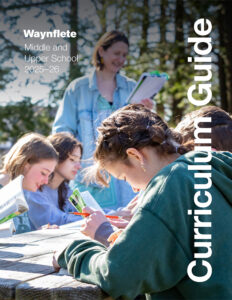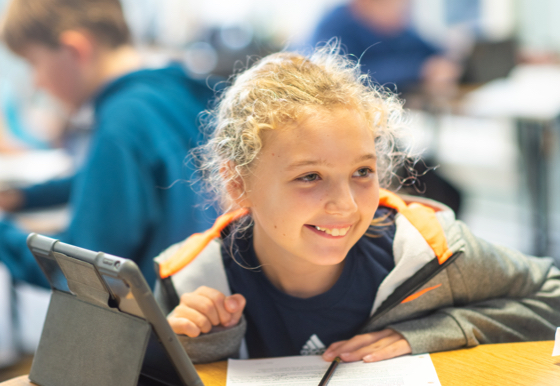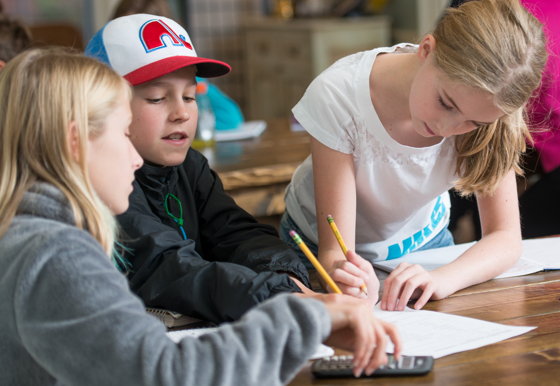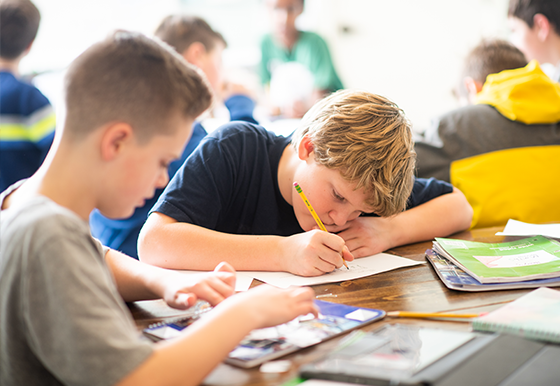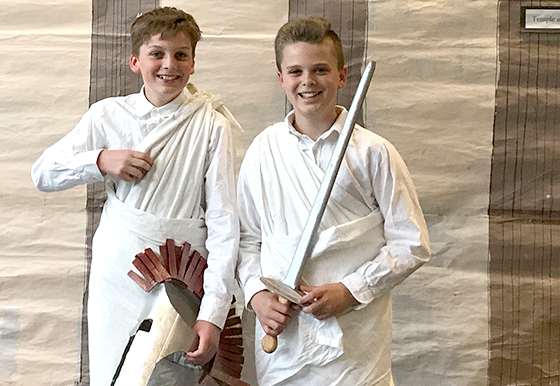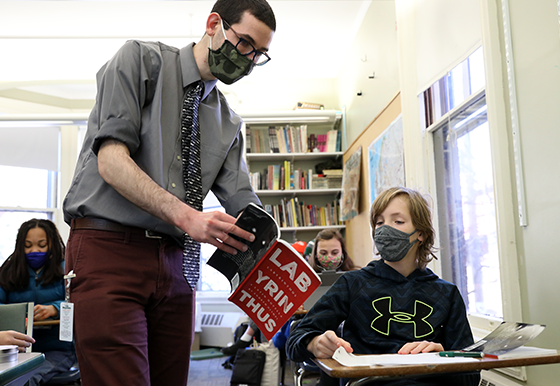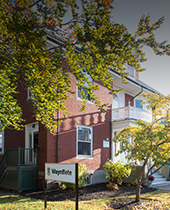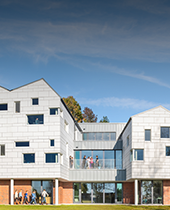
Middle School
Departments and Classes
Waynflete readies students for college-level instruction by offering challenging and fascinating courses not typically found in high schools and our dedicated faculty are given the time and resources to create immersive learning experiences around the strengths and interests of each student.
Within small and highly engaging classes, students spend their days working with primary documents and real-world research, honing their academic writing skills, exploring diverse perspectives, and engaging in lively academic discussion.
Upper School students study American history through the eyes and first-hand accounts of women, Native Americans, and black Americans. Master Mandarin Chinese, Latin, and other classic and world languages. Read philosophy. Gather and analyze complex data for real NASA research projects and state environmental initiatives. Publish a literary magazine, debate ethics in literature and film, compose electronic music, and so much more.
Middle School English Courses
Middle School students devote the majority of their study to reading literature and gaining proficiency in composition. In support of these areas, grammar and vocabulary are focuses each year, often in the context of the student’s writing but also through formal instruction in basic skills. Teachers encourage a process approach to writing—with drafting, peer review, and editing as integral components—whether students are writing exposition, fiction, personal essays, or poetry.
English 6: The Individual and the Community
In connection to the sixth-grade theme, “Adapt, Survive, Thrive,” this course centers on the ancient innovation of storytelling. Throughout the year, students explore two essential questions: Why do we tell stories? What power do stories have? Readings may include The Giver (Lois Lowry), Ramayana: Divine Loophole (Sanjay Patel), and King and the Dragonflies (Kacen Callender). Students sharpen writing skills through daily journaling, creative writing, and analytical writing. In the context of their literature and writing assignments, students practice critical thinking, annotation skills, vocabulary acquisition, and standard grammar usage. Students are also expected to read a book of their choosing and complete a project on it at least twice during the school year.
English 7: My Voice, Our Perspective
This course focuses on stories about adolescence and facing adversity in school and in society. By reading memoirs and fiction by authors of color, students expand their own perspectives and find the courage to grow and share their own voices in the face of challenges. Readings may include The Circuit (Francisco Jimenez), I Am Malala (Malala Yousafzai), Akata Witch (Nnedi Okorafor), and New Kid (Jerry Craft). Each unit is supplemented with creative writing (short story and personal narrative workshops) or expository writing (arguments, thesis statements, textual evidence, and persuasive style). Students build skills in annotating class texts as well as preparing for and participating in class discussions. Quizzes assessing vocabulary, punctuation rules, and grammar are a regular part of the course.
English 8: Justice and Courageous Citizenship
In English 8, students will examine stories in which characters confront injustice and harness courage to effect bold change in themselves and their communities. Core texts include The Hate U Give (Angie Thomas), The Book Thief (Markus Zusak), poetry of the Harlem Renaissance, and selections of contemporary poems and short stories. Students will participate in the American Voices Poetry Project, which asks them to study an American poet’s life and work and consider how they used their writing to change the world. Throughout the year, students will be asked to read closely, think critically, and express their ideas with confidence and precision. They will practice writing regularly in various modes with a strong focus on personal and analytical writing. The overarching goal of this course is to empower students to use their voices to change their world.
Middle School Mathematics Courses
Our Middle School mathematics program is an exploratory and problem-based curriculum that supports students in developing and strengthening their computation skills, number sense, and problem-solving techniques. Students learn by doing math, solving problems in mathematical and real-world contexts, and constructing arguments using precise language. Classroom routines involve a combination of independent work, group work, and whole-class discussions to build conceptual understanding and computational fluency. We provide each student with the appropriate level of support and challenge so they can build their confidence as mathematical thinkers and problem solvers, appreciate the discipline, and reach their full potential.
Grade 6
Math 6 begins with a unit on reasoning about area and understanding and applying concepts of surface area. Work with ratios, rates, and percentages draws on (and builds on) earlier work with numbers and operations. Students then build procedural and conceptual understanding of fractions, focusing on fraction equivalency and the operations of multiplication and division. Finally, students are introduced to more abstract concepts such as expressions, equations, and rational numbers. Throughout the year, students are noticing patterns, making connections, collaborating with peers, discovering algorithms, and building their confidence as mathematical thinkers and problem solvers.
Grade 7
Grade 7 math offerings include Math 7 and Math 7 Accelerated.
Math 7 begins by exploring scale drawings, an engaging geometric topic that reinforces computational skills and number sense while also supporting subsequent work with proportional relationships and percentages. Students then study operations with rational numbers, discovering patterns and processes that extend to simplifying variable expressions and solving variable equations and inequalities. Finally, students put their new skills to work in the context of geometry (angles, triangles, and prisms), probability, and sampling.
In Math 7 Accelerated, students with a solid pre-algebra foundation explore more abstract, algebra-focused topics. Students deepen their understanding of linear expressions and equations and explore systems of equations. Students revisit the definition of an exponent, extend it to include all integers, and learn about orders of magnitude and scientific notation to represent and compute very large and very small quantities. Finally, in the context of the Pythagorean theorem, students encounter irrational numbers for the first time and informally extend the rational number system to the real number system.
Grade 8
Grade 8 math offerings include Middle School Algebra and Algebra 1 Accelerated.
In Middle School Algebra, students begin with a study of geometry: transformations, congruence, dilations, and symmetry. Students build on their understanding of proportional relationships to study linear equations in the coordinate plane. They express linear relationships using equations, tables, and graphs and make connections across these representations. Students also explore systems of linear equations in two variables and learn that linear relationships are an example of a special kind of relationship called a function. Finally, students explore different representations of numbers, codifying the properties of exponents and encountering irrational numbers for the first time.
In Algebra 1 Accelerated, students discover the beauty and abstract nature of algebra. Students revisit systems of equations and inequalities and engage in a more formal study of functions: function notation, domain and range, average rate of change, and features of graphs. These concepts are then applied to piecewise, linear, absolute value, exponential, and quadratic functions. Throughout each unit, applications of functions help students see the connections that exist between graphs, tables, and equations. For each function type, students closely examine the structural attributes of the function and analyze how these attributes are expressed in different representations.
Middle School History Courses
In Middle School, students learn about ancient and classical civilizations; world geography, including in-depth units on Western and non-Western cultures; and American history, with a focus on the Constitution. In every course, heavy emphasis is placed on reading and writing skills, and students learn the step-by-step process involved in writing research papers. Hands-on projects as well as opportunities for debating and role-playing tap into students’ creativity and imagination. Students use technology in a wide variety of ways in support of their work. The entire program is geared to the Middle School child but also serves as an excellent springboard for the Upper School curriculum that follows.
History 6: History of the Ancient World
This course is a yearlong study of ancient cultures, including those of Mesopotamia, Egypt, and China. With a focus on archaeology, students are introduced to artifacts as primary sources that tell the stories of a culture. Consistent with the grade 6 thematic study, ancient cultures are examined with a focus on how individuals innovated to adapt to their environments in order to survive and ultimately thrive. Study skills are embedded in the content, with an emphasis on linear note-taking and expository paragraphs. The year concludes with a thesis-driven research paper about ancient innovations and innovators that includes both a written component and an interactive project on a topic of choice from ancient Egypt, Greece, or Rome, for example.
History 7: Cultural Geography
This course introduces students to a variety of cultures around the world, focusing on the ways in which the physical environment affects the human experience. The year begins with a study of North America, with students writing research papers about the cultural expressions of individual North American Indigenous nations, particularly the Wabanaki in Maine. Students then engage in an immigration unit beginning with why so many people did (and still do) come to Maine in search of new opportunities, including interviews with visitors from Portland’s migrant community. In the spring semester, students explore the geography, history, culture, and current events of Latin America, sub-Saharan Africa, and other regions. Throughout the course, students practice skills such as active reading and note-taking, the development of thesis statements, essay writing, and debate. By studying world geography and cultures, students gain a greater appreciation of diversity within their own local region and its connection to global issues.
History 8: Citizenship and Social Justice in the United States
This course explores themes of justice and courageous citizenship. Students examine the foundational documents of the United States and identify the unfulfilled ideals that have required movements for civil rights and justice in both US history and current affairs. Essential questions include: what are the rights and responsibilities that come along with citizenship, and what does it take to achieve liberty and justice for all? Topics are explored through student-led discussions, close readings of primary and secondary sources, and analytical writing. The course concludes with a research project in which students identify a current issue in the US and present action plans for change.
Middle School Science Courses
The Middle School curriculum introduces students to three major fields of science: life, earth, and physical. In the study of each of these disciplines, scientific inquiry and writing are emphasized. Students gain experience using scientific techniques that include making accurate observations, planning investigations, taking precise measurements, recording data neatly, creating meaningful charts and graphs, and communicating their findings clearly. All courses are activity-based and stress the value of creative problem-solving and working cooperatively with peers.
Science 6: Life Science
Sixth-grade science is a life science course that introduces students to science skills such as observation, data collection, collaboration, and basic scientific writing. In this course, students gain a greater understanding and appreciation of the living world around them and of the complex relationships and processes that exist in nature that allow organisms to adapt, survive, and thrive. Topics include adaptations, microscopy, cell structure and function, infectious diseases, and human body systems. Students perform many activities, laboratory experiments, and research projects throughout the year.
Science 7: Environmental Science
Seventh-grade science students hone their scientific reasoning skills while developing an appreciation for the dynamism of Earth’s interconnected systems. In keeping with the seventh-grade cross-curricular theme of exploring home, students deepen their familiarity with the workings of the planet we call home across multiple scales of time and space. Units of study include astronomical interactions that produce phenomena such as seasons and tides, forces that have shaped the Earth’s surface throughout geologic time, and changes unfolding within Earth’s hydrosphere and atmosphere. Major assignments focus on synthesizing and modeling natural processes, constructing strong scientific arguments from collected evidence, and advocating solutions to environmental challenges such as climate change.
Science 8: Physical Science
Eighth-grade science is designed to give students a foundation in physical science and to fine-tune their lab and scientific writing skills. Through inquiry labs, research projects, and creative experimentation, students explore matter and the changes it undergoes through the lens of introductory chemistry and Newtonian physics. Topics include measurement, the metric system, matter, motion, forces, momentum, and energy transformations.
Middle School Computer Science and Engineering Courses
Middle School students take a trimester course in computer science as well as a course in engineering during grade 6, grade 7, and grade 8. These courses are designed to support thematic studies in each grade.
Engineering 6
Students will use their creativity and ingenuity to solve challenging problems. Working through the engineering design cycle, students learn how to solve problems and iterate solutions that help people adapt, survive, and thrive. This is a hands-on course; students develop digital designs on their iPads and then fabricate them using laser cutters and 3D printers.
Computer Science 7
Students in Computer Science 7 will examine networking technology and cybersecurity. In keeping with the seventh-grade theme of exploring home and community, students will learn what the internet is and how it works to connect communities. They will explore the physical infrastructure of the internet that connects our Waynflete campus and will study and test different methods for keeping information secure. Students also will learn how to build and format a website using HTML. Throughout the trimester, students will engage in discussions about digital citizenship as well as the local and global impact of networking technologies.
Robotics I and Robotics II
Robotics embodies the grade 8 theme of “Change: Destruction, Transformation, Creation.” Robotics is the amalgamation of many forms of engineering—mechanical, electrical, and software. Students will learn how to integrate these fields to create, transform, and destroy Lego robots to accomplish challenging feats. Robotics I will introduce students to Lego SPIKE Prime robots. Students will develop the skills to collaboratively build, program, and problem-solve with their robots. In Robotics II, students will implement their engineering skills to complete longer term, more complex projects of their own design.
Middle School World Language Courses
Courses in French, Latin, Chinese (Mandarin), and Spanish are offered at the Middle School level. As part of a curriculum based on the evolution of human society, all sixth-grade students take Latin. Seventh graders may choose to continue their study of Latin or begin the study of French, Spanish, or Chinese.
Grade 6: Latin
Required for all sixth-grade students, this course is an exploration of the Latin language and of various topics in ancient Roman culture. Students learn core Latin vocabulary and root words, develop reading strategies, and practice communication skills. In addition to these linguistic areas, students also explore the major gods and heroes of Greco-Roman mythology and examine how Rome adapted over the course of its long history to meet the challenges posed by various internal and external threats. This course also helps students hone their study skills and make cross-curricular connections with other sixth-grade courses.
Grades 7 and 8: Latin, Chinese, French, or Spanish
In seventh grade, students may choose to continue their study of Latin or begin another language (French, Spanish, or Chinese). The language choice made in seventh grade is a two-year commitment. Students completing a grade 8 language class may move into level II of their respective language when they enter grade 9, provided that they demonstrate competency on a placement diagnostic at the end of their eighth-grade year.
In Latin 7 and 8, students continue to develop and strengthen their translation skills and expand their knowledge and understanding of the cultural diversity found throughout the history of ancient Rome. Students use the texts Suburani and Lingua Latina per se illustrata. Supplementary materials and primary texts in Latin are introduced as appropriate.
In Chinese 7 and 8, students begin a two-year course of study that develops competence in the four linguistic areas: speaking, listening, reading, and writing. Students learn to read and write simplified Chinese characters. An emphasis is placed on the most basic elements of the Chinese (Mandarin) language as students begin to build a vocabulary and learn simple grammatical structures. The pronunciation of words (pinyin), the four tones, proper stroke order, and character composition are all taught and reinforced throughout the Middle School curriculum. Cultural elements are integrated into the curriculum to supplement the language work with historical and modern context. Students completing Chinese 8 may move into level II when they enter grade 9.
In Spanish 7 and 8, students develop proficiency in the four linguistic skill areas: speaking, listening, reading, and writing. The courses emphasize the importance of communicative competence through activities such as role-playing, rhyming, storytelling, and skits. Exercises include short-answer written and oral responses and descriptive pieces in the present tense as students explore themselves and their communities in a global context. Students learn vocabulary that is focused on the grade’s thematic study.
Middle School Visual Arts Courses
The Middle School visual arts curriculum encourages students to be self-reflective members of society through activities that draw on three fundamental modes of learning: perception, self-expression, and invention. Often using personal narrative and thematic study for content, students use these three modes throughout Middle School as they learn skills in drawing, painting, printmaking, and sculpture. The development of a visual arts vocabulary is consistently emphasized so that students can better understand their own artwork, the artwork of others, and their visual surroundings and heritage. Students take studio art classes twice a week in grades 6–8.
Middle School Performing Arts Courses
The Middle School performing arts program helps foster the artistic, intellectual, and social-emotional growth of our students. The program includes a progression of classes in dance, drama, music, production technology, and music ensembles. Additional performing arts opportunities include the Middle School Play as well as the fee-based dance choreography workshop and private music lessons offered through the Afterschool Enrichment program.
Grades 6 and 7
Performing arts classes meet twice a week. Students develop skills and gain experience by spending one quarter exploring dance, drama, general music, and production technology in each of these grades. These four classes are exploratory, experiential, collaborative, and connected to each other thematically.
Grade 8
The eighth-grade theater class builds on the sixth-grade and seventh-grade performing arts classes. Students explore a range of topics, including theater for social change, public speaking, character development through monologue study, and, finally, collaboration on a full-grade culminating performance. This yearlong experiential class, which is thematically tied to the integrated English and history programs, encourages students to apply their skills as expressive performers, make connections across their academic experience, and strengthen their sense of community.
Grades 6–8 Ensembles
Sixth graders are introduced to ensemble music-making and develop foundational skills through Band 6, Chorus 6, or String Ensemble 6. Seventh and eighth graders come together for more advanced ensemble experiences in Band 7–8, Chorus 7–8, or String Ensemble 7–8. The ensembles rehearse twice a week, and their collaborative journey culminates in performances at music concerts in the winter and spring. They also share their work with the Middle School community at assemblies during the school day.
Middle School Athletic Philosophy And Program
The goals for the Middle School physical education program are to achieve a high level of participation, teach fundamental skills and strategies, develop a sense of teamwork, and foster responsibility and commitment. Every student participates and plays.
Grade 6
Grade 6 students are invited to play on competitive teams in the fall and spring seasons. Sixth graders who do not want to play on a team will have a PE class. All grade 6 students will have a PE class in the winter season. Students are exposed to a variety of sports and activities in PE class. They learn about sportsmanship and teamwork and develop skills and game strategies.
Grades 7 and 8
The Middle School athletic program transitions students to play regular team sports during the seventh and eighth grades. Students are required to participate in either interscholastic athletics or a physical education class each season and can choose from a set of offerings in fall, winter, and spring. Practices take place three times a week and are built into the daily schedule. Most practices conclude in time for students to take regularly scheduled transportation home and are not held on Wednesdays or Saturdays. Games are scheduled for weekday afternoons and go past the scheduled transportation home. Waynflete’s Middle School is a member of the Triple C Conference.
Middle School Sports Options
|
|
WINTER* Basketball Dance Nordic Skiing Swimming |
|
*Not available to grade 6 students
THE WAYNFLETE WIRE
9 proven ways to get kids to succeed in (and love) Middle School.
Middle schoolers need teachers who love teaching kids their age, who find ways to manage a classroom without saying “shush,” and who teach the essential skills that help students organize their work, their thinking, and mostly importantly, themselves. Read More
